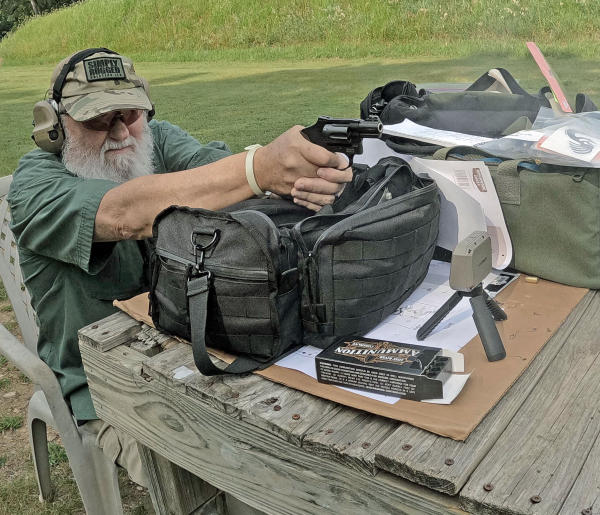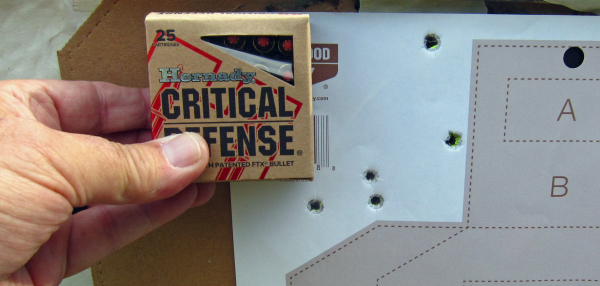
My original intent was to combine the 32 and 38 versions of the Ultimate Carry revolver line, conceptualized by Lipseys and Smith & Wesson, in a single review. For those who came in late, revolver connoisseurs Daryl Bolke and Bryan Eastridge were called in to consult on the project. The gun specified was an alloy-frame “Centennial” (concealed hammer) revolver, with improved visibility sights – regulated to hit center at useful snub distances with available loads – and improved “high horn” stocks, all of which have to come in at a lower price point than the M340PD/M&P340 revolver line.
There was pilferage from that line with the two-piece barrel which makes assembly easier and facilitates installation of another front-sight system. The new guns have titanium action pins for durability in the long term.
VZ Grips worked extensively trying to make a high horn stock that met the needs. They did well, but the damn things are still hard, made from G10 as they are.
What is G10? I don’t know, so I went to the source.
That tells me that the material is a “high-pressure fiberglass laminate” of glass cloth layers, similar to a boat hull. Soaking the glass in epoxy resin, they use heat and pressure to form the item into the shape needed. Moisture resistant, it’s durable stuff that won’t become brittle or soften over time.
They’re still hard and the gun is still light.
Why a 32? And why not the 327 Federal Magnum? That would offer more flexibility.
Well, a 640 – especially the Pro Series type – in 327 Federal Magnum might scratch that itch for a few. Still, it’s a lot of horsepower in not much weight. For the old-timers in the crowd, consider the 32 WCF (the 32-20) cartridge; loaded by factories in two flavors, one for handgun and one for rifle, it was a favorite in the Winchester lever action rifle and the Colt Single Action Army. Shooting the rifle load in the revolver could get sporty – especially when Colt chambered their lightweight D-frame Police Positive Special in 32 WCF.
That got the shooter’s attention, quickly. I fired the 327 Fed. Mag in the Ruger SP101. That gun is a veritable tank compared to Airweight S&Ws – and I didn’t like shooting the 327 in the SP101. In the same firm’s Blackhawk single action revolver, I imagine it’d be closer to the discontinued Blackhawk in 30 Carbine.
The combined crew at S&W and Lipseys got this right; 32 H&R is the practical limit for this gun.

Shooting at Range Ready in Louisiana in February, I thought the 32 was vastly easier to shoot than the 38. I found, when shooting for velocity over a Garmin Xero Pro C1 – a chore shared with fellow scribbler Rob Garrett – the 38 and 32 were nearly indistinguishable with some loads. The heavy Double Tap wadcutter that earlier had sailed through two 16” blocks of Clear Ballistics gel and hit the backstop with enough authority to injure a human being, that 32 load was a bit much through the M432 UC.
At home, I tried a few loads for velocity and accuracy. Shooting at 20 yards and having used XS Sights before, I held the “ball” front sight up out of the “bucket” of the rear sight. The load struck high, just to the left of the headbox of the Birchwood Casey BC EZE-Scorer 12” x 18” BC IPSC reduced size silhouette. This was with the first load of the day, Hornady Critical Defense 80 grain FTX 32 H&R Magnum.

The VZ Grips high horns did me no favors; that load is a thumper out of the M432 UC. The load averaged 928 FPS. The group was 3 5/8” at 20 yards, with the best three hits going into 1 1/8”. I imagine the hammering of the proximal thumb joint contributed to opening the group.
The Lost River 100 grain Poly Coat wadcutter averaged 761 FPS – but that’s out of a short barrel. With the bullet weight, it too gave a thumping to the shooter. A three-inch group resulted with the best three in 1 ¼”.
There’s a pattern here. And holding the sights level put the round where I held. Federal Champion 95gr. lead SWC traveled at an average 863 FPS and yielded a vertical string. I was wondering if the recoil got the better of me, but the best three covered 3 ¾”. I’m considering this an anomaly.
Sellier & Bellot makes a pleasing to shoot 100 grain wadcutter load that travels at a sedate 640 FPS. The three-inch group was likely more the shooter, though the shorter round had further to travel before it hit the forcing cone. The "best three" group was close, at 2 7/8”.
I put a 3x5” label in the middle of the BC EZE-Scorer A-zone, vertical, and did some closer work with my meager supply of S&B Wadcutter. Staying in the 3x5” label was no chore at 7-10 yards. I confess to some low hits out of the upper A-zone of the reduced size silhouette with that load.
Would I put softer stocks, bigger though they may be, on this 32? Yes. In fact, I have – and I’m waiting to get back out to the range to see if there’s an appreciable difference with 32 H&R loads.
And how about the gun? It’s what the J-frame revolvers should have always been – light, easy to shoot as well as easy to carry.
They hit a home run with the UC revolvers. The 38 – just recently received – will come up soon.
— Rich Grassi